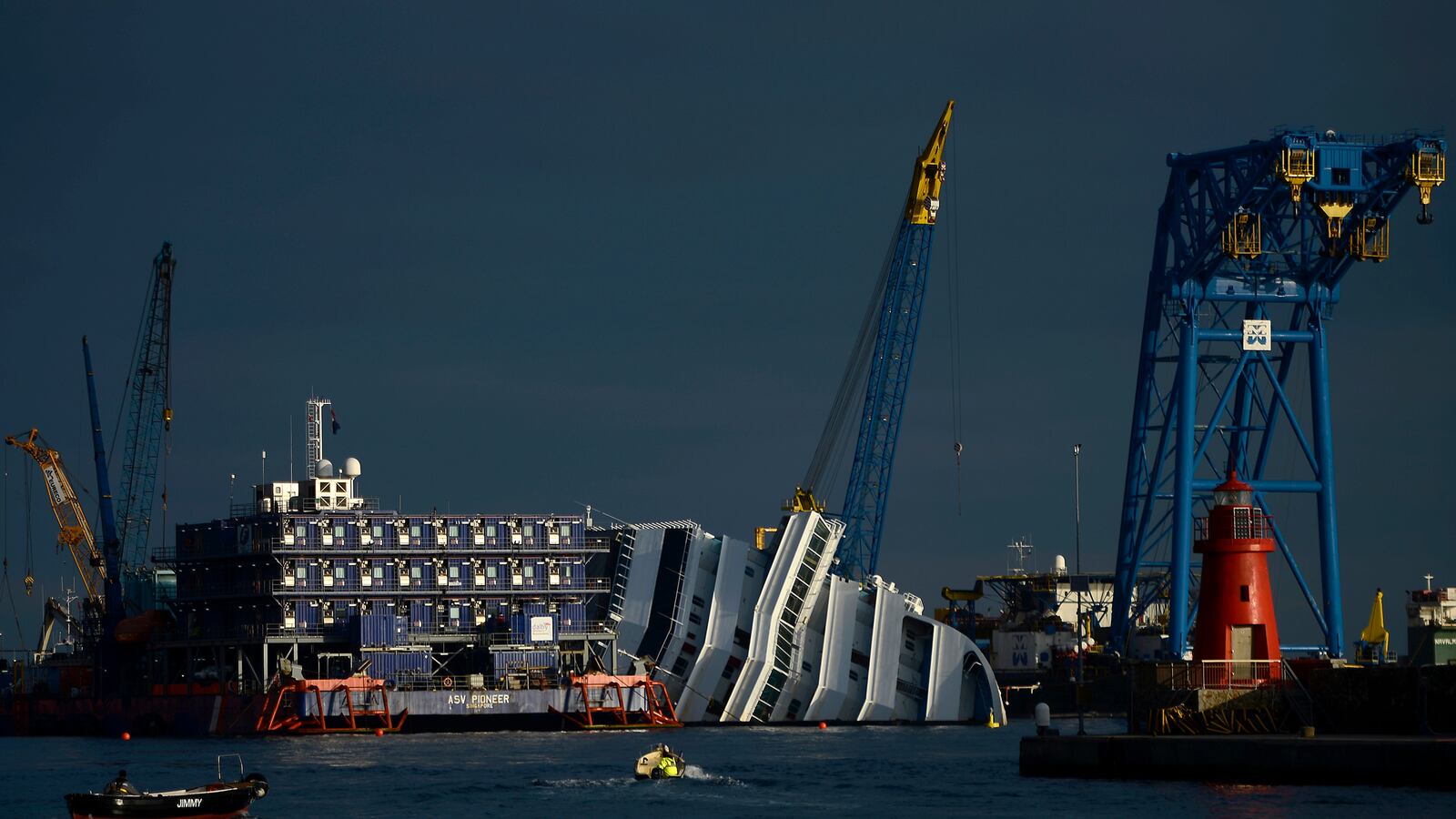The putrid stench of rotting food is a daily distraction for the 420 men and women working on the salvage operation of the Costa Concordia cruise ship that crashed off the island of Giglio on the Tuscan coast on Jan. 13, 2012. The ship had just embarked from Civitavecchia carrying enough fish, meat, and poultry to feed 4,200 passengers and crew for 10 days before it crashed. Most of the food is still in the storage lockers and freezers, protected from the fish and marine life, and now so rotten that the smell has permeated the seals and cases. Seagulls swoop over the wreckage, drawn by the odor.

The ship looks almost nothing like it did a year ago. Its bright yellow funnel is gone, and the boulder that was lodged in the hull has been removed. The wreck is rusting and dirty, and is now dwarfed by giant barges holding cranes and equipment on one side, and on the other by a massive floating dormitory where most of the 420 men and women from 19 countries who are working on the operation live. At night, the ship is lit up like a circus and a constant hum of generators and drills fills the air.
This is the largest-ever attempted maritime salvage operation, and while all involved say they are optimistic it will work, the risks involved are apparent. “Weather is our enemy,” says Nick Sloane, the South African project chief for American-based Titan Salvage. “We are working ’round the clock to get the job done as fast as we can.”
Sloane estimates that his crew will be able to roll the ship to an upright position, a maneuver known as parbuckling, by the first week of July if the weather cooperates. Once it is in an upright position, it will take several weeks longer to drain it and lift it before it can be towed to an Italian port where it will be scrapped. Costa, which owns the wreckage and is paying the estimated $400 million to remove it, is expected to make a decision by the end of February where to tow it. “Not all ports are suitable for such a salvage operation,” Franco Gabrielle, head of Italy’s civil protection unit. “We have to take into consideration how long it will take to tow the ship and how long to scrap it.”
It will still be many months before it matters where the ship ultimately docks. Only the first of four phases of the salvage operation has been completed. The Concordia has been secured with chains and giant cables drilled into the seabed, so that even a major sea storm poses less of a threat of dislodging the ship from the two underwater peaks it rests upon. Now the crew of divers and welders is drilling underground holes for 26 giant pillars below the ship. When the holes are ready, four massive platforms will be shipped in from steelyards across Italy where they were built and placed on the pillars. The work is very precise, and the holes, pillars and platforms must be perfect since they are not being constructed on the same site. Tons of cement will secure the platforms that will eventually hold the 114,000-ton ship in place while it is prepared for lifting and towing. The margin of error is just 1 percent, says Sloane, who describes the platforms as a “bed” on which the Concordia will ultimately rest. He gives the operation a 70 percent chance of success, which he says is good.
“There is a lot of calculating, recalculating, and validating the calculations in an operation like this,” he says. “There is no room for mistakes.”
By the end of February when the giant platforms should be in place, huge containers called sponsons, which are about the height of a 10-story building, will be welded onto the above-water side of the ship, creating a sort of shell around the original vessel that will be used both to control its movement and keep it together when it is lifted. Because the ship was not designed to carry such weight, workers are also reinforcing the vessel’s walls. “We expect some structural damage inside the ship when we lift her,” says Sloane. “But the outer walls are what need to hold and those will be strong enough.”

The lifting of the ship will take between six and eight hours, and Sloane hopes to have it upright around the first week of July. After it has been uprighted, sponsons will be welded to the starboard side that has been underwater for a year. The bodies of the last two victims may then be recovered from under the ship. But once the parbuckling process begins, there is no turning back, Sloane says. “At a certain point gravity will take over, and we won’t be able to stop the roll,” he says. “That’s why everything has to be so precise.”
On Sunday, the island residents are holding an all-day ceremony to commemorate the one-year anniversary of the disaster that has forever changed their island. There will be concerts and a Mass in the city church where so many passengers took refuge the night of the wreck. They will also be returning the giant boulder that was lodged in the hull of the ship the night of the accident back where it came from. And at 9:45 p.m., the moment of impact one year ago, 32 lanterns will be lit for those who lost their lives in the accident. The workers will also observe a minute of silence. “Not a day goes by that the workers don’t think about why they are on this job,” says Sloane. “Nobody on the crew ever forgets about the people whose lives were impacted by this accident.”






